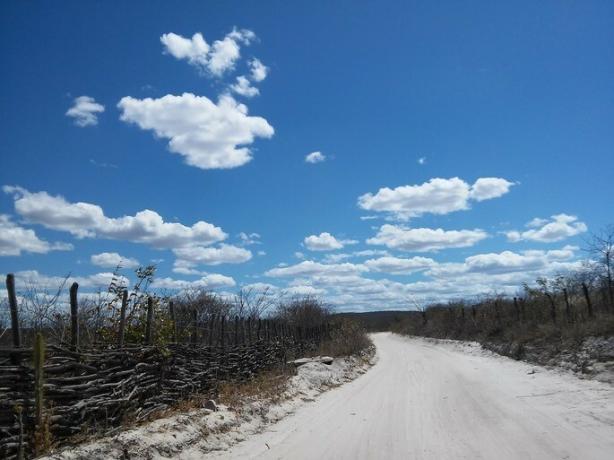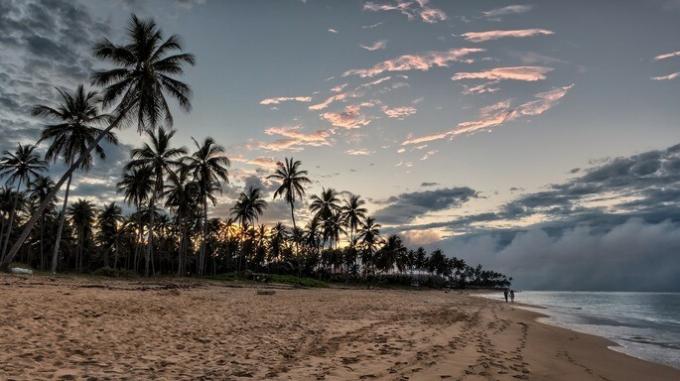O Northeast Region Climate has determinant characteristics in the formation of different landscapes in the region.
The Northeast Region, formed by the states of Maranhão (MA), Piauí (PI), Ceará (CE), Rio Grande do Norte (RN), Paraíba (PB), Pernambuco (PE), Alagoas (AL), Sergipe (SE) and Bahia (BA), has a territorial extension of 1,554,291,607 km2.
In the northeast region, four types of climate predominate:
- Wet Tropical or Coastal Tropical
- Tropical Semiarid
- Tropical
- wet equatorial

Humid Tropical Climate
O humid tropical climate or tropical coastal, has a hot and humid summer, with high temperatures throughout the year, ranging between 25 and 31 degrees.
It has a season with irregular rains, with greater occurrence between the months of April and July, with an average annual rainfall between 2,000 and 3,000 millimeters.
This climate is prevalent throughout the Zona da Mata. It comprises a strip of land that follows the coast and extends from Rio Grande do Norte to southern Bahia.
It is in this region that the capitals of the Northeastern states are located, with the exception of Teresina, Fortaleza and São Luís.
The humid tropical climate is also predominant in the Zona do wild, in part of the states of Rio Grande do Norte, Paraíba, Pernambuco and Alagoas.

The high plateaus and the Agreste mountains form barriers for the penetration of humid air masses from the Atlantic Ocean.
The eastern portion of the Agreste, close to the Mata zone, rains more than the western portion, close to the sertão.
In the regions of the mountains and the Borborema Plateau, the temperatures, during the rainy period, come to fall, oscillating between 14 and 24 degrees. The cities of Gravatá (PE), Garanhuns (PE), Triunfo (PE), Campina Grande (PB) and Lagoa Seca (PB) deserve to be highlighted.
Semi-arid tropical climate
O semiarid tropical climate it has low humidity, with average temperatures around 27 and 31 degrees, reaching 41 degrees in long dry periods.
Rains are rare, with a rainfall index of less than 700 millimeters per year, and may occur between the months of April and May.
The lowest annual average of rainfall in Brazil is registered in Cabaceiras, in the interior of Paraíba, with only 278.1 millimeters.

The semi-arid tropical climate is predominant in the central portion of northeastern Brazil. Found in part of the State of Piauí, in the Middle North and in part of the Zona do Sertão, in the states of Ceará, Rio Grande do Norte, Paraíba, Pernambuco, Sergipe and Bahia.
The big problem in the sertão is the irregularity of the rains. When it doesn't rain in the expected months, there are periods of drought, with high temperatures and that can last for several years.
O Drought Polygon it is a region recognized by legislation within the semiarid region of the Northeast. It has different levels of aridity, with extremely dry areas, typical of semi-desert.
The area affected by droughts has been increasing, due to climatic phenomena and deforestation in the region. This is the case of the State of Maranhão, which until 30 years ago did not experience drought.
Tropical weather
O tropical weather features two well-defined seasons. The summer is hot and rainy with high temperatures, and dry winter, with prolonged drought and mild temperatures, between 18 and 26 degrees.

The pluviometric index varies between 1,000 and 1,750 millimeters. It is predominant in a large part of Maranhão, Piauí, Ceará and Bahia.
Wet Equatorial Climate
O wet equatorial climate it has high average temperatures, between 25 and 27 degrees, with an average annual rainfall of 2,000 to 3,000 millimeters, with a large amount of rain most of the year.

It predominates in a narrow strip in the state of Maranhão, on the border with the state of Pará, in the North Region.
See more about the northeastern climate in this video:
Learn more about the Northeast:
- Northeast region
- Northeast culture
- Northeast Region Economy
- Northeast States
To learn more about weather, read also Brazil climates and test your knowledge with Exercises on Climates in Brazil.


